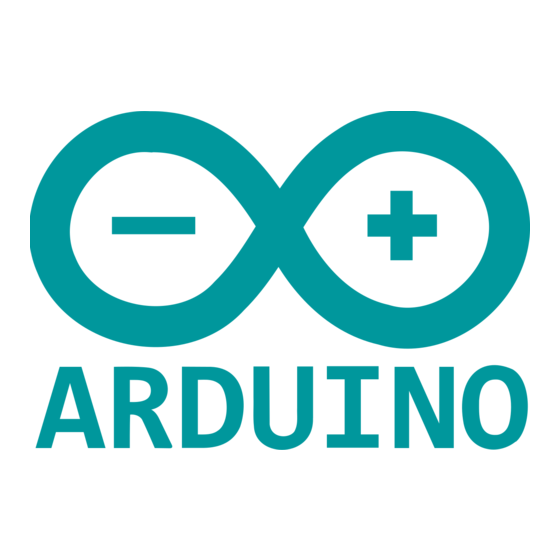

Arduino Nano 33 IoT Product Reference Manual
Hide thumbs
Also See for Nano 33 IoT:
- User manual ,
- Product reference manual (18 pages) ,
- User manual (15 pages)
Table of Contents
Advertisement
Quick Links
Arduino® Nano 33 IoT
Product Reference Manual
SKU: ABX00027
Description
The Arduino® Nano 33 IoT and Arduino Nano 33 IoT with headers are a miniature sized module containing a Cortex M0+ SAMD21
processor, a Wi-Fi® + Bluetooth® module based on ESP32, a crypto chip which can securely store certificates and pre-shared keys and a 6
axis IMU. The module can either be mounted as a DIP component (when mounting pin headers), or as a SMT component, directly soldering
it via the castellated pads.
Target areas:
Maker, enhancements, basic IoT application scenarios
1 / 15
Arduino® Nano 33 IoT
Modified: 06/06/2024
Advertisement
Table of Contents

Summary of Contents for Arduino Nano 33 IoT
- Page 1 Description The Arduino® Nano 33 IoT and Arduino Nano 33 IoT with headers are a miniature sized module containing a Cortex M0+ SAMD21 processor, a Wi-Fi® + Bluetooth® module based on ESP32, a crypto chip which can securely store certificates and pre-shared keys and a 6 axis IMU.
- Page 2 Arduino® Nano 33 IoT Features SAMD21G18A Processor 256 kB Flash 32 kB Flash Power On Reset (POR) and Brown Out Detection (BOD) Peripherals 12 channel DMA 12 channel event system 5x 16 bit Timer/Counter 3x 24 bit timer/counter with extended functions...
- Page 3 Arduino® Nano 33 IoT Nina W102 Module Dual Core Tensilica LX6 CPU at up to 240MHz 448 kB ROM, 520 kB SRAM, 2MB Flash Wi-Fi® IEEE 802.11b up to 11Mbit IEEE 802.11g up to 54MBit IEEE 802.11n up to 72MBit 2.4 GHz, 13 channels...
-
Page 4: Table Of Contents
3.4 Crypto 3.5 IMU 3.6 Power Tree 4 Board Operation 4.1 Getting Started - IDE 4.2 Getting Started - Arduino Cloud Editor 4.3 Getting Started - Arduino Cloud 4.4 Sample Sketches 4.5 Online Resources 4.6 Board Recovery 5 Connector Pinouts 5.1 USB... -
Page 5: The Board
USB or headers. NOTE: Nano 33 IoT and Nano 33 IoT with headers only supports 3.3V I/Os and is NOT 5V tolerant so please make sure you are not directly connecting 5V signals to this board or it will be damaged. Also, as opposed to Arduino Nano boards that support 5V operation, the 5V pin does NOT supply voltage but is rather connected, through a jumper, to the USB power input. - Page 6 Arduino® Nano 33 IoT Board topology top Ref. Description Ref. Description ATSAMD21G18A Controller LSM6DSOXTR IMU Sensor NINA-W102-00B Wi-Fi®/Bluetooth® LE Module ATECC608A-MAHDA-T Crypto Chip Micro USB Connector IT-1185-160G-GTR Push button Board topology bottom Ref. Description Ref. Description Open solder bridge (VUSB)
-
Page 7: Processor
I C peripherals (IMU and Crypto). NOTE: As opposed to other Arduino Nano boards, pins A4 and A5 have an internal pull up and default to be used as an I C Bus so usage as analog inputs is not recommended. -
Page 8: Imu
The board has an embedded 6-axis IMU which can be used to measure board orientation (by checking the gravity acceleration vector orientation) or to measure shocks, vibration, acceleration and rotation speed. Source code for the Arduino Library that supports the IMU is available [15] 3.6 Power Tree... -
Page 9: Board Operation
4.1 Getting Started - IDE If you want to program your board while offline you need to install the Arduino Desktop IDE [1] To connect the Nano 33 IoT to your computer, you’ll need a Micro-B USB cable. This also provides power to the board, as indicated by the LED. -
Page 10: Connector Pinouts
Arduino® Nano 33 IoT 5 Connector Pinouts Pinout 5.1 USB Function Type Description VUSB Power Power Supply Input. If board is powered via VUSB from header this is an Output (1) Differential USB differential data - Differential USB differential data +... -
Page 11: Headers
Arduino® Nano 33 IoT 5.2 Headers The board exposes two 15 pin connectors which can either be assembled with pin headers or soldered through castellated vias. Function Type Description Digital GPIO +3V3 Power Out Internally generated power output to external devices... -
Page 12: Mechanical Information
Arduino® Nano 33 IoT 6 Mechanical Information 6.1 Board Outline and Mounting Holes The board measures are mixed between metric and imperial. Imperial measures are used to maintain a 100 mil pitch grid between pin rows to allow them to fit a breadboard whereas board length is Metric. -
Page 13: Certifications
7.2 Declaration of Conformity to EU RoHS & REACH 211 01/19/2021 Arduino boards are in compliance with RoHS 2 Directive 2011/65/EU of the European Parliament and RoHS 3 Directive 2015/863/EU of the Council of 4 June 2015 on the restriction of the use of certain hazardous substances in electrical and electronic equipment. -
Page 14: Conflict Minerals Declaration
Tin, Tantalum, Tungsten, or Gold. Conflict minerals are contained in our products in the form of solder, or as a component in metal alloys. As part of our reasonable due diligence Arduino has contacted component suppliers within our supply chain to verify their continued compliance with the regulations. -
Page 15: Company Information
Arduino® Nano 33 IoT 9 Company Information Company name Arduino S.r.l Company Address Via Andrea Appiani,2520900 MONZA 10 Reference Documentation Reference Link Arduino IDE https://www.arduino.cc/en/software (Desktop) Arduino Cloud https://create.arduino.cc/editor Editor Arduino Cloud Editor - Getting https://docs.arduino.cc/arduino-cloud/guides/editor/ Started Arduino https://docs.arduino.cc Documentation Arduino Project https://create.arduino.cc/projecthub?by=part&part_id=11332&sort=trending... - Page 16 Mouser Electronics Authorized Distributor Click to View Pricing, Inventory, Delivery & Lifecycle Information: Arduino ABX00027...




Need help?
Do you have a question about the Nano 33 IoT and is the answer not in the manual?
Questions and answers